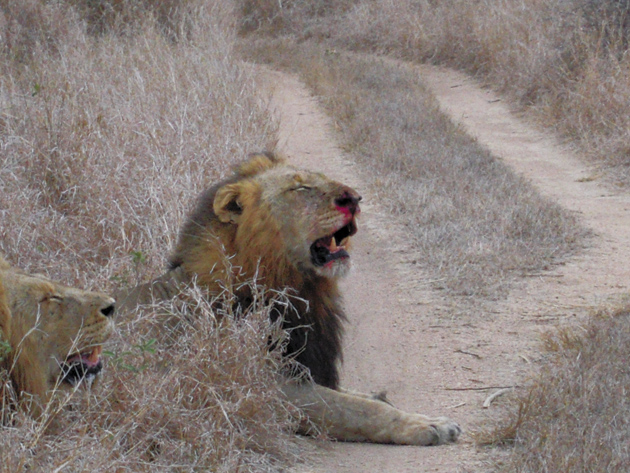We saw him on our first game drive. We had left the camp at about 4 PM and it was shortly after that. The vehicle stopped by a clearing between some small trees and Alfie, the ranger, said, “Lion.” We couldn’t see him.
“Where?” Camouflage and jetlag together can be blinding.
Alfie pointed again. “There.”
Then we saw him. He was right there, fifteen feet from us, lying flat on his left side, feet toward us, the rangy edges of a mane further on. We had arrived at Londolozi, in the Sabi Sands game reserve, 65,000 hectares (160,550 acres) adjacent to Kruger National Park in the northeast of South Africa, only an hour earlier from Paris.
Bennett, the tracker, who sat on a seat protruding over the front left of the jeep—he called it his “office”—hopped casually off his perch and climbed into the vehicle with us, so that it would have no visual irregularities that might look unusual to the lion. The jeep is completely open, no roof, exposed on all four sides. There is a rifle perched across the dashboard, but Alfie says he has never had to use it. After decades of seeing Land Rovers, with little, chattering, camera-snapping, hat-wearing humans sitting inside, the animals—lions, leopards, elephants, giraffes, rhinos, hippos, hyenas—not only appear entirely unthreatened but hardly seem to notice us at all. Just don’t get out of the jeep and don’t stand up in the jeep. Then you’re meat. There are a few deaths every year in Kruger, Alfie says: someone taking that all- important, final close-up.
The lion’s sandy color matched perfectly the rubble-studded dirt on which he was lying. But once you saw him, you saw nothing else, and immediately felt the joy of safari: one’s shrunken significance, one’s thin shadow. Five hundred pounds, a great mound of lion muscle, napping. He didn’t flick a whisker at the vehicle driving up and stopping. But when Alfie started the motor again he lifted his heavy head slowly and looked our way with drowsy disdain. A mammoth weary warrior, his whole body ticked with scars, his mane many mottled shades from blond to black, punk and jagged on his head. His right nostril appeared bigger and blacker than the left, an old wound. He closed his eyes again, and laid his great head back down. We had been dismissed.
One cannot really see animals in a zoo. The safety provided by the cages and enclosures completely distorts perception. Only in the wild, where the animals are free and man is the curious visitor, caged in his jeep, can one feel the power of their dangerous beauty, the enormity of their dignity, and the frailty—and occasional idiocy—of humans. As with the American we saw in another vehicle photographing, with his twelve-inch lens, a young male lion while wearing a baseball cap topped with a miniature stuffed lion.
We saw the same lion two days later, about 7:30 in the morning. I recognized him because of the scar on his nose. He was with his brother and three females: a mother and her two grown daughters. The mother had no tail. She had lost it along with two of her four cubs in a hyena attack four years ago. The two remaining cubs are the grown daughters with her now. They killed a baby hippo a few hours ago and are feeding, each in turn: the males first, then the females. Their bellies are bulging.
Earlier that morning, in a large pond just outside the camp, we counted twenty-eight hippos in the water. They stay there all day and only exit —single file along their narrow hippo path—to feed at night. They cannot swim, and stand in the shallow water. We watched one baby hippo lying crosswise over its mother’s back, stumpy legs draped over each side of her huge slippery body, bobbing up and down in the water as the mother went up and down as hippos do.
We saw this same group of lions a day later on a failed hunt. The females led, spreading out in three directions to surround an impala, the two males languidly following at the rear. They will help only if the prey is so large that the females can’t do it alone. But the males always eat first. The impala got wind of them and escaped, and the five lions reassembled at a clearing and took a long nap preceded by plenty of paw- and face-cleaning and licking of each other. And finally, one female rolled over and slept on her back, belly and feet to the sky. It was then, while all was quiet, that Alfie told us that they call the male Satan, the one with the scarred nostril.
Advertisement
The rangers and trackers know the animals—there are about sixty lions in Sabi Sands, and they know each pride, all the males—but they do not appropriate them by naming them. Except for this one lion.
“He is a bad lion,” said Alfie with little emotion.
The next afternoon, sometime after five, Bennett pointed to the left, climbed down from his “office,” and got in the jeep with us. It was already getting cold. Alfie drove on, then turned left. Running at a good clip straight toward us was a lioness, followed at short range by Satan, with his brother close behind. She made a sharp right in front of the vehicle and the males followed her. Alfie made a sharp left and followed them, mowing down several acacia bushes along the way, as we ducked the two-inch thorns. The three lions had stopped a short space away. Satan, panting, was standing, blood dripping from his nose into his mouth and onto his chin. “They were fighting,” said Alfie.
The lioness buried herself on her belly in some tall yellow brush, almost invisible except that the grass about her head grew slowly red. The two males settled about eight feet from her, beside each other. The panting slowed down and all became quiet. What was going on? Our jeep was just behind the lioness, only ten feet from her. We waited in silence. The minutes passed, maybe ten. Satan stands up, turns around, cocks his head up, sniffs the wind, and opens his jaws, showing huge bloody incisors. I wonder if he is in pain.
The violence was so quick, so out of the silence that I remember only a few flashed images. Satan’s brother circled, imperceptibly, around behind the lioness and the two attacked her from both front and back. Incredibly loud growls and roars, she is on her back, paws to her neck, protecting her spine and throat from their jaws. Awful, awful throaty noises and suddenly our vehicle is jolted to one side. Satan has hit the back corner, full-force, and we all are knocked sideways to the right. There is blood among the lions but I don’t know whose. Alfie turns on the motor and asks if we want to stay or go. “Go.”
We drive off, leaving the three lions alone. It is now that Alfie explains about Satan.
“He has been killing lionesses for years. He has killed many lionesses.”
Male lions kill other male lions over territory, females, food. And they will kill the cubs of another male lion. But very rarely do they kill lionesses. It does not serve them genetically. Satan is not, now, in his own territory, which belongs to the pride of the lioness we just saw him attack. With his brother—who Alfie says is not “bad,” just a “follower”—he tries to mate with a lioness and when she refuses him, as she almost always will since she doesn’t know him and he is not of her pride, he tries, often with success, to kill her. He had attacked another one only two days ago but she got away.
Once, Alfie says, they watched him mate for two days straight with a lioness he had killed. “We have never seen this before.” Satan’s behavior—a serial rapist, necrophiliac, killer—is deviant, the need to dominate gone awry, even for a lion. But in a conservation reserve like Sabi Sands, humans do not interfere, even with a criminal animal. It is the lions who must deal with their own, and Satan remains at large.
If he is deviant, crazy, I ask Alfie, how does he know that Satan won’t jump in the jeep and attack us? Alfie shakes his head and says, “He won’t. He’s not interested in us.”
We drive on and see the pride of the lioness, about a half-mile away. I count thirteen lions, including the dominant male with a scraggly dark mane, and a handsome young male whose thick reddish mane is just filling in around his neck. He is about three and half years old, and the son, Alfie tells us, of the lioness Satan just attacked. She separated herself from her pride, he explains, to divert Satan and his brother from them, her family as it were. The females in a lion pride are related: mothers, daughters, sisters, aunts. I watch the young lion, beautiful and alert, watching, seeming to look in her direction. But it is probably just the wind.
We follow the pride on a hunt. They have spotted a baby warthog. Too late for the capture, we arrive in time to see the still squealing animal in four mouths: those of the alpha male, the handsome young male, an even younger male, and the female who made the kill. All four growl and pull simultaneously and the animal is literally torn into four rather unequal pieces. Each settles down to eat, blood, meat, skin, and bones, crunch-crunch. The entire pride had eaten earlier and the other females wait patiently. The little warthog was a chance snack. Finished, the pride strolls down to a small watering hole and drinks, nuzzling and licking one another. We watch them for a while and then head back to camp. As the sky darkens, the Southern Cross appears above us. I wonder how the lioness is.
Advertisement
The next day we hear that she was wounded badly in the attack, her back broken, her spinal cord gouged, paralyzed. She had been seen by some rangers but they weren’t encouraging guests to go that way anymore.
The morning we were leaving Sabi Sands I asked Alfie about the lioness.
“She died yesterday,” he said.
I thought of her lying by the small brush bush where she was last seen, with her broken back, taking two days to die. Alfie says that Satan has two more years to rampage before he gets too old to keep killing other lions. Unless, I think, the young lion challenges him. But it would not be to avenge his murdered mother. It would be to protect his pride.
This Issue
November 5, 2009






